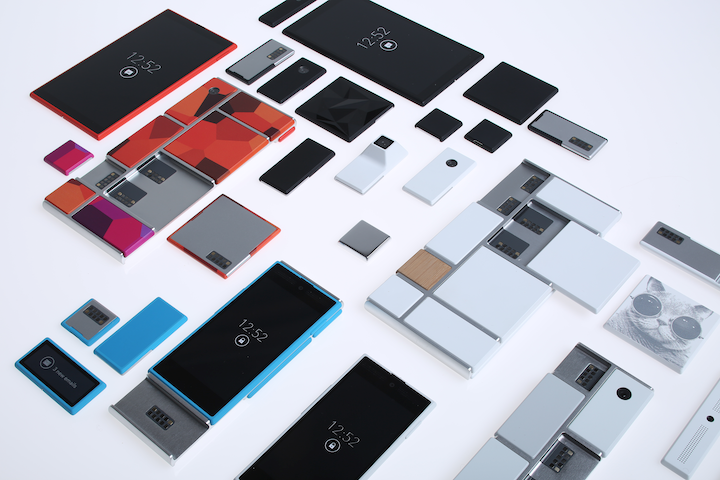In its small red brick headquarters, Vanderbilt’s Institute for Software Integration Systems (ISIS) is working on a revolution in smartphone technology. It’s not better screens, or battery life, or anything for a major carrier. It’s a puzzle-piece phone that will (hopefully) change the way the military communicates.
Headed by former DARPA program manager Janos Sztipanovits, ISIS is already responsible for part of the military’s efforts to build a hyper-secure smartphone. The institute plays a key role in DARPA’s Transformative Apps program, the Department of Defence’s attempt to create an app ecosystem that soldiers can use on the battlefield.
But funding for TransApp will run out at the end of the year, so naturally project lead Sandeep Neema is looking for the next big thing. In a recent interview, he told me that thing is, without a doubt, Google’s Project Ara and the modular smartphone.
A Phone for Any Situation
You’ve no doubt heard of pie-in-the-sky the dream of PhoneBloks into the real world.
The challenge is interesting enough (and the team bright enough) that Google held onto ATAP — team motto: “We like epic shit.” — when it sold Motorola to Lenovo last year. Earlier this year, Google hosted the first Ara developer’s conference, and now the ATAP at Google is now working in tandem with the Android team.
If Ara sounds like a crazy DARPA project, that’s because it kind of it is. ATAP itself is led by former DARPA director Regina Dugan, and several of the research teams that Google’s contracted to help out on the lofty effort have also worked on DARPA projects. Neema’s ISIS team is one of them.
It’s not hard to see why technology like the Ara phone would appeal to the military in particular. Your average Joe might not take kindly to a bulky, modular solution as opposed to the slick phones we have today. But for the military, anything that’s not a giant radio is an upgrade, the ability to change specs on the go could prove to be utterly crucial instead of just moderately handy.
A couple of months ago, DARPA’s own Doran Michels explained how Project Ara could be transformative in the military’s efforts to create a battlefield-ready smartphone. “Things like Ara, Google’s modular phone — which I think is pretty cool — is great because the idea that we could make one housing and that’s always [the same],” Michels told me. “Then, as we need capabilities we can add those modules such as more memory or more processing or more battery.”
Right now, the military’s experimenting with off-the-shelf consumer devices like the Samsung Galaxy Note. For the most part, these devices work well, but customisation proves problematic. It’s possible to connect external hardware to conventional smartphones, but it has to be through a single MicroUSB port since that’s all that most consumer devices support. Meanwhile, taking pieces out is effectively impossible.

The ISIS team echoed Michels’ enthusiasm about how the Ara phone could help the military overcome this challenge. “The whole idea behind the Ara is that you’re able to add specialised hardware to the phone,” explained Ted Bapty, a member of the ISIS team. “I think you could think of a lot of things that the military would do that would require extra hardware: geiger counters, chemical sensors… just a wide range of applications.”
A Deep Engineering Challenge
Project Ara basically aims to create a hardware equivalent for Android, a platform on top of which an infinite number of possibilities can be built. It also addresses some of the unavoidable security concerns that come with consumer-grade smartphones, namely the fact that their Wi-Fi and Bluetooth chips can’t be easily removed.
Imagine a soldier on a mission needs only three things from his smartphone. One, he needs it to connect securely to his radio so that his buddies know where he is. Two, he needs to make sure the battery doesn’t die. Three, a multi-touch screen, but also one versatile enough to shine brighter than the Afghani sun during the day and dim enough that he doesn’t give away his position to the enemy at night.

A consumer-grade smartphone would have trouble doing all three of those things at once. Battery life is a real problem in part because the phones are wasting power on functions that the soldier doesn’t need. The screen issue is also a tough challenge, because the best screen for sunlight isn’t necessarily the best screen for darkness. It’s not hard to imagine how an Ara phone could address these issues, though. Just swap between OLED and e-ink screens when needed and add extra modules for extended battery life. Easy.
Those opportunities do not come without risks, however. “If you talk to people, they all say it’s insane that you could build these kinds of things so that you can hot swap these modules and applications and everything,” ISIS director Janos Sztipanovits told me on a recent visit to Vanderbilt. “That creates a very deep engineering challenge. How can I make everything compatible and guarantee that it still keeps working and delivers and doesn’t lock up? It’s a hard problem.”
But ISIS engineers like Neema and Bapty are working on it. They’re on a team that’s helping to develop the standards that would make Ara modules completely hot-swappable. You can imagine how one company might be able to manufacture all of the modules so that they’re perfectly compatible, but that’s not the point. The mission behind Project Ara is to democratize hardware.
A Moon Shot
Project Ara a compelling idea but the phone also doesn’t really exist, at least not in the sense that you can just pick one up, or put in an order for a suite of the things. When I asked about an ETA for the Ara, a Google spokesperson said, “We’re working towards a limited market release in 2015.” That is, presumably, if nothing goes wrong, and something almost certainly will.
Ara’s a moon shot coming from a company that loves taking moon shots. Google does have a pretty good record of making those shots, too. You don’t have to look any further than the company’s self-driving car saga to realise how Google can pick up a DARPA project — or in the Ara’s case, a DARPA-like idea — and turn it into reality. And assuming that the military maintains its interest in implementing a modular phone, there’s clearly a lot of money to be made building the best one.
But spending a couple of days at ISIS, I realised that money’s sort of the last thing on these guys’ minds. The place smells strongly coffee because the engineers are working tirelessly through the summer, trying to figure out this deep engineering process for the sake technological innovation, and because it’s a tough puzzle to solve. Janos told me, “We work like hell.” And I believe him. They’re working like hell so that our troops don’t have to go through hell on the battlefield. If that’s not a noble goal, I don’t know what is.
Images by Jim Cooke / Project Ara / Google / DARPA
